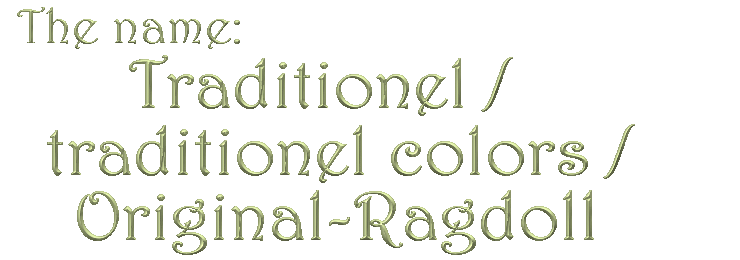Traditional Ragdoll / traditional Colors or Original-Ragdoll
(Original Ragdoll = OR / New-color Ragdoll = NR)
Why do we refer to the pure breed of the Ragdoll as the “Original-Ragdoll”? The label “traditional Ragdoll” has been widely used for Ragdolls when referring to the traditional phenotype. Traditional Ragdolls may be Orginial-Ragdolls, or they may be Ragdolls that are not registered in D. Dayton's genetic database. These are referred to as NRs (“New-color Ragdolls”).
Let me explain the problem.
An “Original-Ragdoll” (OR) has one or more of the following phenotypes:
color points, mitted, or is bi-color with seal, blue, chocolate and lilac.
A “New-color Ragdoll” (NR) has, in addition to the above, a tabby, tortie, torbie, solid (one color, no dots) appearance; eye color other than blue, or the alternative colors of red and crème.
There are breeders that breed to achieve only traditional colors and traditional fur patterns. These Ragdolls all look like ORs, but would not be considered as Original-Ragdolls based on their ancestry.
Just because the animal has the original phenotype does not necessarily mean that it is an Original-Ragdoll. Many breeders are not aware that there are two distinct lines of Ragdolls: the original 'pure line' and the 'color line'. The 'color line' has been crossed with completely different breeds (races).
organisation FIFé
Because the FIFé recognized the additional colors (tabby, tortie, torbie, red and crème) in 2004, some breeders are under the false assumption that those Ragdolls are Orginial-Ragdolls.
To elaborate, a few anecdotes are highlighted below:
– If asked about Original-Ragdolls, the breeder might respond, “Yes, they all have the traditional colors.”
However, a Ragdoll with traditional coloring should not automatically be assumed to be an Original-Ragdoll.
– Or the database has an entry of an NR of the 5th or 6th Generation with 'tabby' or 'red' noted. The breeder's comments are: “That is an original Ragdoll, because the new color is not listed on the pedigree anymore!”
– Other breeders say: “The sire of my female cat Lilly is an OR and the dam is an NR. If I pair my female cat Lilly (which is a NR because of her mother!) with an OR stud, the progeny I get will be Original-Ragdoll(s) again.”
– An Original-Ragdoll was paired with a NR. The breeder declares, “That's not so bad. The progeny is only 1% not original.” This breeder has not realized that any ancestors from that particular NR, cannot be labeled as an OR because it is not an Original Ragdoll anymore.
– And finally: “Hello! How nice that you are breeding Original-Ragdolls. I do the same! I am looking for a stud with chocolate or red colors”. After checking the breeder's website, one can see that his Ragdolls have all possible colors - red, lynx, crème, tortie, etc (the new colors recognized by FIFé in 2004). Once the breeder is being made aware of the mistake, the standard response is: “Oh, that's funny. I never heard of such a thing!”
This begs the question: What do the breeders actually know about their own breed?
Dear readers, the cats referred to in the above examples are not Original-Ragdolls, even if some supposedly have the 'traditional colors'.
So, what do we learn from this?
“Ragdoll” does not equal “Ragdoll”! The difference is that the real Original-Ragdoll has all of its ancestors of all of its lines listed in Denny Dayton's database. There are no exceptions! It is a shame that so many breeders don't know anything about the history of the “Original Ragdoll”, the breed they are fostering.
There are certainly positive reactions as well:
“I am looking for a Ragdoll as a pet. A friend of mine told me to be careful with buying a Ragdoll, because there are two types - the Original and others. Can you please explain the difference?”
Therefore, if you want an “Original-Ragdoll”, get a written, binding confirmation. Remember to check the pedigree before you buy, especially if you buy a cat to participate in the Original-Ragdoll breeding program. The VdOR can help you. It doesn't cost you anything to send the pedigree of the parent cats to the VdOR for verification.
To order certificate:
To check pedigree:
